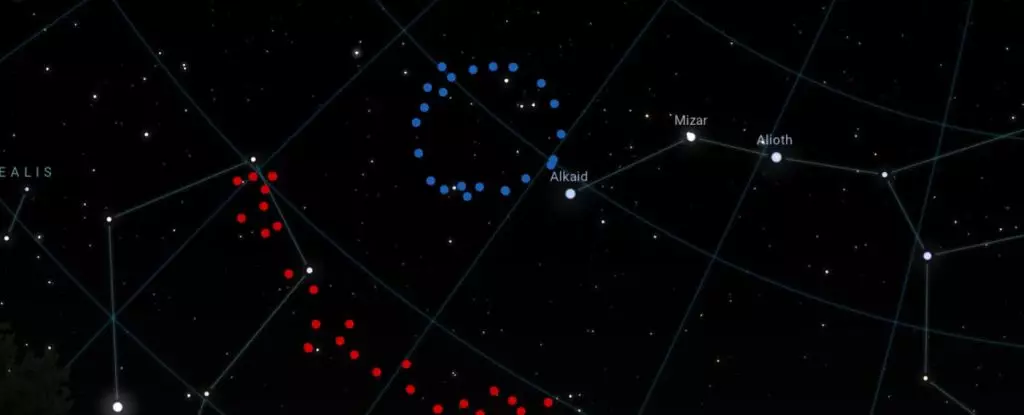In a groundbreaking discovery that has reverberated across the scientific community, astronomers have encountered an astonishing cosmic structure that challenges our fundamental understanding of the Universe. Dubbed “The Big Ring,” this colossal formation consists of a nearly perfect ring of galaxies spanning an astonishing 1.3 billion light-years in diameter. Its discovery, led by astronomer Alexia Lopez from the University of Central Lancashire, was presented at the 243rd meeting of the American Astronomical Society in 2024, subsequently gracing the pages of the Journal of Cosmology and Astroparticle Physics. The implications of the Big Ring could reshape our knowledge of cosmic evolution and force us to rethink established theories in cosmology.
Another Cosmic Enigma
This revelation marks the second significant astronomical find by Lopez and her team, following the Giant Arc unveiled in 2021, which is located in the same region of the sky and exhibits similar perplexities. The announcement of the Giant Arc intrigued scientists, yet the discovery of the Big Ring deepens these mysteries manifold. Lopez eloquently summarized the conundrum: “Neither of these two ultra-large structures is easy to explain in our current understanding of the universe.” This challenges not only astronomers’ interpretation of cosmic structures but also raises the question: what do these findings mean for our comprehension of the Universe?
Defining Cosmic Structures
The prevailing thought in cosmology posits that the Universe operates under the Cosmological Principle, which asserts that the Universe appears homogeneous and isotropic on large scales. Traditional models have established a size limit for observable structures at approximately 1.2 billion light-years, and yet both the Giant Arc and the Big Ring vastly exceed this size. Lopez further explains, “We expect matter to be evenly distributed everywhere in space when we view the universe on a large scale, so there should be no noticeable irregularities above a certain size.” The appearance of these gargantuan formations goes against the grain of the standard cosmological model, sparking debates about their implications for the very fabric of space-time.
BAOs Versus Cosmic Anomalies
At first glance, the Big Ring might seem analogous to Baryon Acoustic Oscillations (BAOs), expansive circular arrays of galaxies that represent the remnants of ancient acoustic waves. However, the Big Ring is distinctive; it diverges from BAOs, which have a defined size of around 1 billion light-years. Interestingly, investigations reveal that the Big Ring manifests with a corkscrew-like configuration rather than a perfect circle, suggesting that it deviates profoundly from conventional cosmic structures.
The nature of cosmic evolution is rooted in the relationship between structure formation and the behavior of the early Universe, leading to an urgent inquiry: what exactly does this newfound shape signify?
Alternative Cosmological Models
With such remarkable discoveries, scientists are compelled to consider alternative cosmological models that could potentially account for these startling findings. One significant hypothesis stems from Roger Penrose’s concept of conformal cyclic cosmology, which posits an endless series of Big Bang expansions. Within this framework, extraordinary structures like the Big Ring might be anticipated. Yet, it is crucial to acknowledge that this theory also encounters substantial obstacles and faces scrutiny in its own right.
Another intriguing avenue of exploration relates to the idea of cosmic strings—topological defects that may have formed as the fabric of space-time expanded in the early Universe. While empirical evidence of cosmic strings remains elusive, the theoretical implications are curiously promising. What if these unusual galaxy arrangements arise from such cosmic phenomena? The possibilities are as vast as the Universe itself.
The Future of Cosmic Discovery
The Big Ring and its counterpart, the Giant Arc, compel the scientific community to question the prevailing assumptions about the Universe. As observational technologies advance and data collection becomes ever more sophisticated, the hope remains that additional ultra-large structures may lie in wait, hidden within the cosmic tapestry. Discovering more of these formations could elucidate the intrinsic relationships governing galaxy distribution and provide a clearer picture of the essence of cosmic architecture.
Lopez poignantly captured this anticipation: “From current cosmological theories, we didn’t think structures on this scale were possible.” Each revelation pushes the boundaries of our understanding, driving science forward. The extraordinary findings challenge the very framework through which we view the cosmos, and thus, ignite a newfound curiosity and enthusiasm for what lies beyond the stars. As we delve deeper into the mysteries of the universe, we may unearth answers to questions previously deemed unimaginable.


Leave a Reply